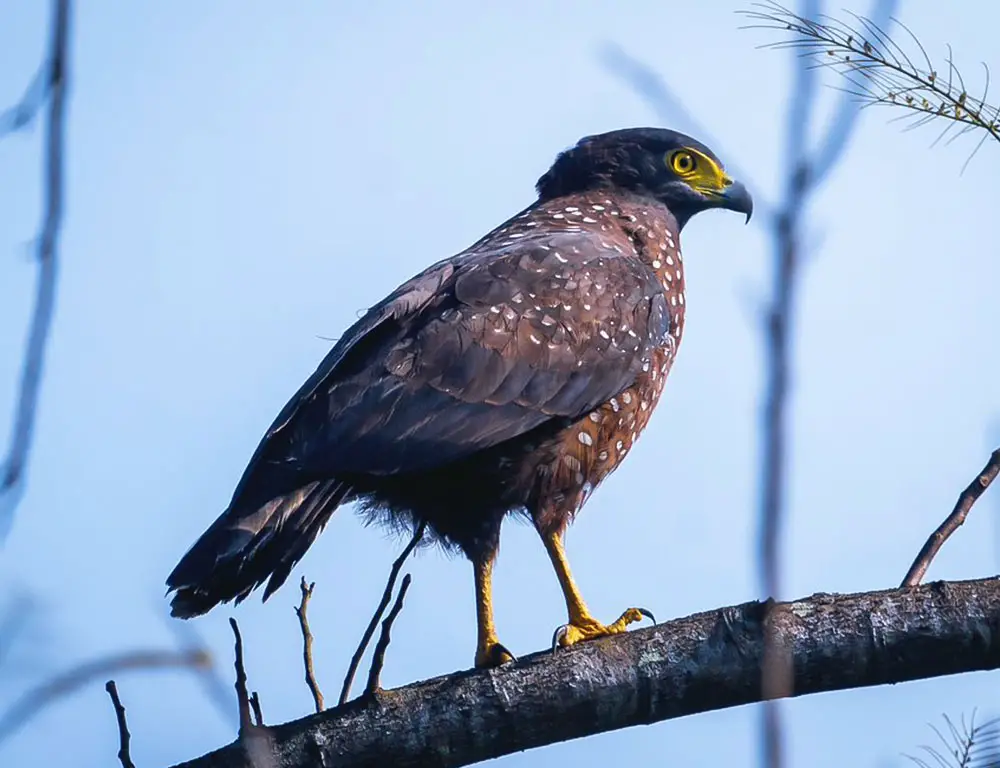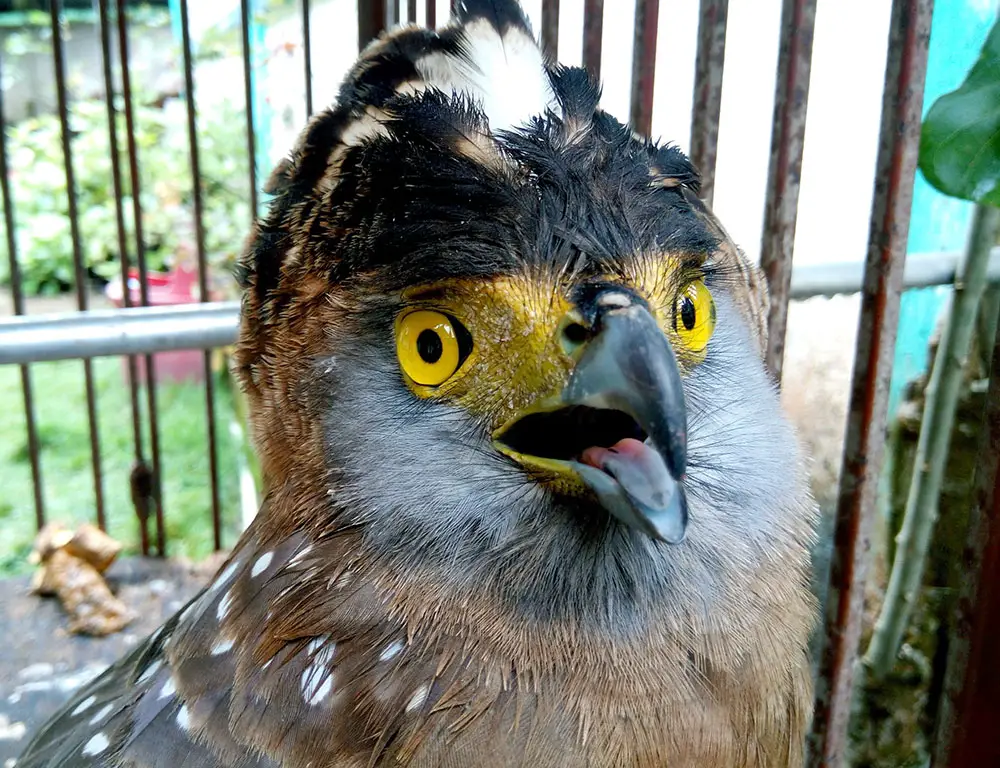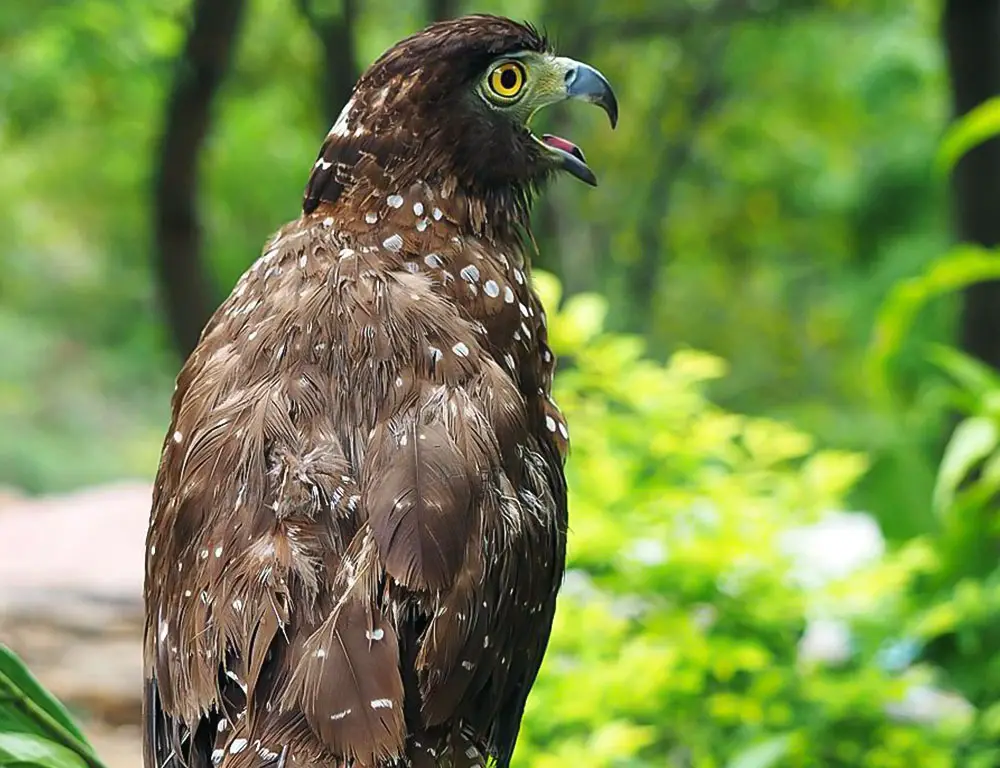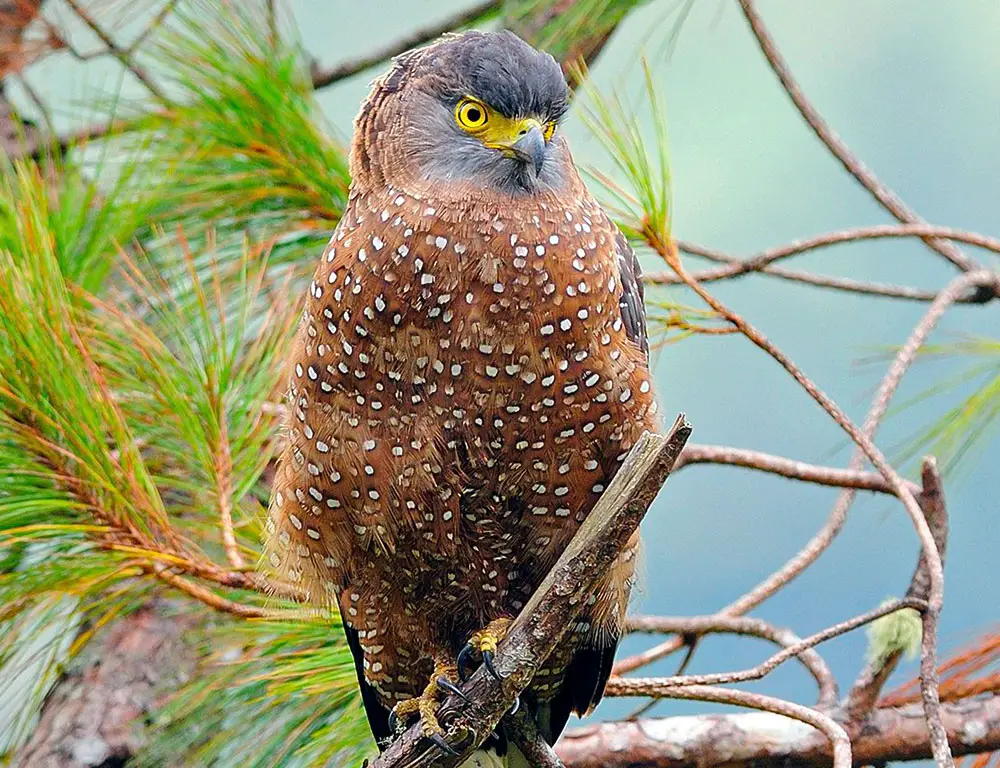The Philippine Serpent Eagle, scientifically known as Spilornis holospilus, captivates with its mesmerizing presence and captivating behavior.
Exclusive to the Philippine archipelago, this bird of prey epitomizes the harmony of raw power and grace as it glides effortlessly over forest canopies in search of prey.
Its keen eyesight and stunning plumage add to its allure, drawing admirers to delve deeper into its world.
Beyond its physical attributes lies a realm of exploration into survival tactics, evolutionary adaptations, and environmental challenges.
From its aerial hunting prowess to its distinctive call and nesting habits, each aspect of the Philippine Serpent Eagle offers insights into the delicate balance of nature and the intricacies of our world.

Physical Characteristics of the Philippine Serpent Eagle
The Philippine Serpent Eagle (Spilornis holospilus) possesses various physical characteristics, making it a fascinating subject for study within the avian kingdom.
Here’s a detailed overview:
Size
The average length of an adult Philippine Serpent Eagle ranges from 18 to 20 inches (approximately 45 to 50 centimeters), making it a medium-sized raptor.
Wingspan
It has a wingspan ranging from approximately 100 to 120 centimeters (39 to 47 inches), providing the necessary surface area for efficient gliding and soaring.
Body Structure
These eagles have a streamlined body shape, which aids in efficient flight and maneuverability.
Their long, broad wings allow them to soar effortlessly through the air, while their feathered legs extend down to yellow-colored feet equipped with sharp talons for grasping prey.
Beak
The beak of the Philippine Serpent Eagle is notable for being hooked at the end, a characteristic trait common among birds of prey. This hooked beak is well-adapted for tearing up food, particularly flesh from captured prey.
Eyes

One of the standout features of the Philippine Serpent Eagle is its large, piercing brown eyes. This keen eyesight enables the eagle to spot movement from great heights, playing a crucial role in its hunting success as it scans the forest canopy for potential prey.
Coloration
The plumage of the Philippine Serpent Eagle exhibits a distinctive coloration scheme.
The upper parts of the bird are primarily brown, while the underparts are white with fine brown streaks, giving them a somewhat scaly appearance reminiscent of a serpent, hence the name “Serpent Eagle.”
The head and nape may also bear short black feathers, forming a crest-like appearance. The tail feathers are banded with black and white stripes, creating a striking pattern that stands out during flight.
Habitat and Distribution of the Philippine Serpent Eagle
The Philippine Serpent Eagle (Spilornis holospilus) is native to the Philippines, occupying various habitats across the archipelago.
Here’s an overview of its habitat and distribution:
Preferred Habitat
Philippine Serpent Eagles are typically found in forested areas, including primary and secondary forests. They thrive in lush greenery with towering trees and dense vegetation, providing ample cover for hunting and nesting.
While they prefer undisturbed forest habitats, they have also been observed in cultivated lands and edge habitats near human settlements.
Geographic Range
The Philippine Serpent Eagle is endemic to the Philippines, found nowhere else. These eagles inhabit various islands within the Philippine archipelago, from Luzon north to Mindanao south.
They have a wide distribution across the country, but their populations may vary in density across different regions.
Altitude Range
These eagles can be found across a range of altitudes within their habitat. While they are commonly observed at low elevations, they can also inhabit higher elevations, reaching up to approximately 1,900 meters above sea level in mountainous regions.
Specific Habitats

While Philippine Serpent Eagles primarily occupy forested areas, they may also utilize other habitats within their range. This includes forest edges, where the forest meets open land, and the agricultural regions with nearby forest cover.
However, their preference remains for dense forest environments where they can hunt their preferred prey, such as snakes.
Behavior and Diet of the Philippine Serpent Eagle
The behavior and diet of the Philippine Serpent Eagle (Spilornis holospilus) offer intriguing insights into the lifestyle and ecological role of this fascinating bird of prey within its natural habitat.
Hunting Techniques
The Philippine Serpent Eagle is known for its exceptional hunting abilities, honed through evolutionary adaptation to its forested environment. It employs various techniques to capture prey effectively:
- Aerial Hunting: These eagles often soar high above the forest canopy, utilizing their keen eyesight to scan for potential prey. From this vantage point, they can spot movement on the ground or in the trees below, enabling them to identify and target potential prey items such as snakes, lizards, or small mammals.
- Sit-and-Wait Strategy: Another common hunting tactic employed by Philippine Serpent Eagles is the sit-and-wait strategy. They perch motionless on high branches or treetops, patiently observing their surroundings for signs of prey activity. Once a suitable target is detected, the eagle swoops precisely and quickly to capture its prey.
- Ambush Predation: With remarkable agility and stealth, Philippine Serpent Eagles can launch surprise attacks on unsuspecting prey from concealed positions within the forest canopy. This ambush predation technique allows them to capitalize on the element of surprise, increasing their chances of successful hunting endeavors.
Diet
The diet of the Philippine Serpent Eagle is diverse and adaptable, reflecting its opportunistic feeding habits and ability to exploit a wide range of prey resources within its habitat.
While snakes are a primary component of their diet, these eagles also consume a variety of other prey items, including:
- Reptiles: As their name suggests, Philippine Serpent Eagles predominantly feed on snakes. They are skilled hunters of various snake species, including venomous and non-venomous snakes in their habitat.
- Amphibians: Frogs and other amphibians are also significant prey items for Philippine Serpent Eagles. They may hunt for amphibians in wetland areas or near water sources within their forested habitat.
- Small Mammals: Additionally, these eagles occasionally prey on small mammals such as rodents, shrews, or bats when opportunities arise. While not as common as reptiles or amphibians, small mammals provide an alternative food source for Philippine Serpent Eagles.
- Insects: Insects, including beetles, grasshoppers, and other arthropods, may supplement the diet of Philippine Serpent Eagles, particularly during times of scarcity or when hunting larger prey is impractical.
Ecological Role
As apex predators within their ecosystem, Philippine Serpent Eagles play a crucial role in regulating prey populations and maintaining ecological balance.
By controlling populations of snakes and other small vertebrates, they help to prevent the overpopulation of prey species and contribute to the overall health and stability of the ecosystem.
Conservation Status of the Philippine Serpent Eagle

The conservation status of the Philippine Serpent Eagle (Spilornis holospilus) is a topic of concern due to various survival threats, primarily from habitat loss, hunting, and pesticide exposure.
Understanding these challenges is crucial for implementing effective conservation measures to ensure the long-term viability of this species.
Threats
The Philippine Serpent Eagle faces several threats to its survival, primarily from human activities and habitat degradation. Here are some of the critical threats:
Habitat Loss
Deforestation, driven by logging activities and land conversion for agriculture and infrastructure development, poses a significant threat to the Philippine Serpent Eagle’s habitat.
As forests are cleared and fragmented, the eagles lose essential nesting sites, foraging grounds, and prey resources.
Hunting
Despite legal protection, Philippine Serpent Eagles are still targeted by hunters for sport or food. Illegal poaching exacerbates population declines, particularly in areas where enforcement of wildlife protection laws is inadequate.
Pesticide Exposure
Intensified agricultural practices, including the indiscriminate use of pesticides and chemical fertilizers, result in contamination of the environment.
Exposure to toxic chemicals can directly harm Philippine Serpent Eagles through ingesting contaminated prey or indirect exposure via bioaccumulation in the food chain.
Conservation Efforts
Conservation efforts aimed at protecting the Philippine Serpent Eagle involve a combination of strategies focused on habitat conservation, law enforcement, community engagement, and raising awareness.
Here are some key conservation efforts:
Law Enforcement
Increased enforcement of wildlife protection laws is essential for combating illegal logging and hunting activities that threaten the Philippine Serpent Eagle’s survival.
Strengthening law enforcement efforts, including patrolling protected areas and prosecuting offenders, is crucial for deterring illegal activities and safeguarding eagle populations.
Habitat Restoration
Restoration of degraded habitats through reforestation and rehabilitation projects is critical for providing suitable habitats for Philippine Serpent Eagles.
Efforts to restore forest ecosystems enhance nesting sites, foraging opportunities, and connectivity between fragmented habitats, promoting the recovery of eagle populations.
Public Awareness Campaigns
Educating local communities and raising awareness about the importance of conserving wildlife, including the Philippine Serpent Eagle, is essential for fostering public support and engagement in conservation efforts.
Public awareness campaigns can promote responsible environmental stewardship, encourage sustainable land use practices, and empower communities to take proactive measures to protect eagle habitats.
FAQs
What is the average lifespan of a Philippine Serpent Eagle in the wild?
Philippine Serpent Eagles in the wild typically live for about 10 to 15 years, although some individuals may live longer in optimal conditions.
How does the Philippine Serpent Eagle communicate with other eagles?
The Philippine Serpent Eagle communicates through various vocalizations, including calls, shrieks, and screams, which establish territory, attract mates, and communicate with offspring.
What is the nesting behavior of the Philippine Serpent Eagle?
Philippine Serpent Eagles build their nests high in the canopy of trees, often using sticks, twigs, and foliage to construct a sturdy platform. They typically lay one to two eggs per breeding season, and both parents share in the incubation and care of the chicks.
How does the Philippine Serpent Eagle defend itself against predators?
Philippine Serpent Eagles rely on their agility, keen eyesight, and swift flight to evade predators. If threatened, they may emit alarm calls, puff up their feathers to appear larger, or engage in aerial maneuvers to escape danger.
What role does the Philippine Serpent Eagle play in its ecosystem?
As a top predator, the Philippine Serpent Eagle helps regulate populations of prey species, contributing to the overall balance and health of the ecosystem. By controlling populations of snakes and small mammals, they help maintain ecological harmony in their habitat.
Conclusion
The Philippine Serpent Eagle stands out as a remarkable bird species in the diverse ecosystem of the Philippines. Its striking appearance, adaptive nature, and unique behaviors like monogamy make it a subject of fascination and admiration.
Despite being classified as ‘Least Concern’ by the IUCN, ongoing conservation efforts are crucial to safeguard its habitat and address threats such as habitat loss and hunting.
As stewards of the environment, it is imperative to continue raising awareness and implementing conservation measures to ensure the long-term survival of this majestic species.
Through our collective efforts, we can preserve the beauty and resilience of the Philippine Serpent Eagle for future generations to appreciate and cherish.